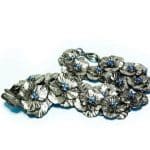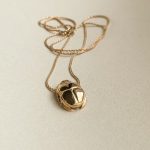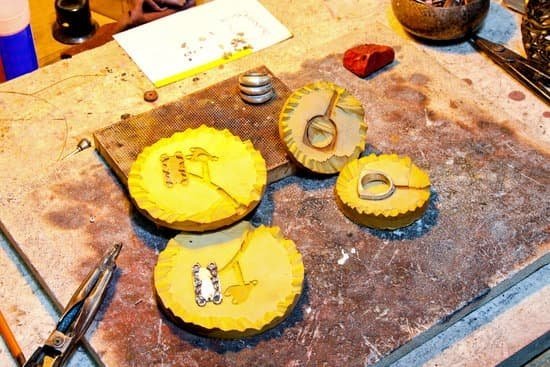Old jewelry has a certain allure that captivates many people. Whether it’s the intricate designs, the nostalgic appeal, or the stories they carry, old jewelry holds a special place in our hearts. But what about the diamonds and chips embedded in these pieces? Are they worth anything? In this article, we will explore the potential value of diamonds and chips in old jewelry and shed light on why they still matter.
Diamonds have long been coveted for their beauty and rarity. These precious stones can be found in various shapes and sizes, often gracing old jewelry pieces that have been passed down through generations. However, it is not just diamonds that contribute to the value of old jewelry – small gemstones known as “chips” can also play a significant role. While their size may be modest compared to traditional faceted diamonds, chips add an undeniable charm and character to vintage pieces.
Understanding the worth of diamonds and chips in old jewelry requires some knowledge of their distinguishing features. Differentiating between genuine diamonds and artificial stones or glass impersonators is crucial. Factors such as carat weight, color, clarity, and cut are all important considerations when assessing a diamond’s value. Similarly, evaluating the quality of chips involves examining their condition and size. By delving into these aspects, we can better comprehend the potential worth embedded within old jewelry.
As we embark on this exploration of diamonds and chips in old jewelry, we must remember that their value extends beyond purely financial aspects. Historical significance plays a vital role in determining their worth as well. The age and context surrounding a piece of jewelry can elevate its sentimental value to unparalleled heights. In further sections of this article, we will delve into these factors alongside expert opinions from jewelers who specialize in appraising valuable antique pieces.
So if you’ve ever wondered whether those diamonds or chips adorning your grandmother’s ring or your great aunt’s pendant are worth anything at all – join us on this journey. Let’s unveil the hidden treasures and discover the value that diamonds and chips in old jewelry truly hold.
Understanding the Basics
When it comes to old jewelry, one of the most common questions that arises is whether the diamonds and chips found in these pieces are actually worth anything. To answer this question, it’s essential to understand the basics and differentiate between diamonds and chips, as well as assess their potential worth.
Firstly, let’s differentiate between diamonds and chips. Diamonds are gemstones that have been cut and faceted to reflect light, resulting in their signature sparkle. They are valued for their rarity, durability, and beauty. On the other hand, chips refer to small pieces or fragments of diamond or other gemstones that have chipped off from larger stones or have been damaged over time.
Now let’s consider the potential worth of diamonds and chips in old jewelry. Diamonds can hold significant value depending on various factors such as carat weight, color, clarity, and cut. These factors are collectively known as the 4 Cs of diamond evaluation. The higher the carat weight (the size of the diamond), the rarer it is and thus commands a higher value.
Colorless or near-colorless diamonds are highly sought after compared to those with a noticeable yellow or brown tint. Clarity refers to how clear or free from internal flaws a diamond is – fewer imperfections result in a higher value. Lastly, a well-cut diamond reflects light optimally which enhances its brilliance.
On the other hand, evaluating the quality of chips involves assessing their condition and size. Chips that are smaller tend to have less impact on overall value compared to larger ones. Additionally, chips that are closer to the edge or corner of a stone may also affect its worth more significantly as they may weaken its structure.
Overall, while diamonds generally hold more value than chips due to their rarity and inherent qualities, both elements can contribute to the overall worth of old jewelry. In our next section, we will delve deeper into the factors that determine the value of diamonds and chips in old jewelry, shedding light on how you can accurately assess their worth.
Factors that Determine the Value
One of the key factors that determine the value of diamonds and chips in old jewelry is their quality. When it comes to diamonds, the 4 Cs – carat weight, color, clarity, and cut – play a crucial role in assessing their worth. Carat weight refers to the size of the diamond, with larger diamonds generally being more valuable.
Color refers to how white or how yellow a diamond appears, with colorless diamonds being considered more valuable. Clarity refers to the presence of any internal flaws or blemishes in the diamond, with flawless diamonds being highly valued. Cut refers to how well the diamond has been shaped and faceted, with well-cut diamonds reflecting light better and therefore being more valuable.
In addition to diamonds, chips also have their own set of factors that determine their worth. The condition and size of the chips are two main aspects that impact their value. Chips that are in good condition without significant signs of wear or damage will generally be worth more than those that are heavily damaged. The size of the chip also has an influence on its value, with larger chips usually commanding higher prices.
Another factor that can greatly affect the value of both diamonds and chips in old jewelry is their historical significance. The age and historical context of a piece of jewelry can add to its desirability and rarity, thus increasing its value. For example, if a piece of old jewelry is associated with a famous historical event or person, it may be considered a highly sought-after collector’s item.
Overall, when determining the worth of diamonds and chips in old jewelry, it is important to consider factors such as quality (for diamonds), condition and size (for chips), as well as historical significance. These factors all play a crucial role in assessing the value of these precious gems and ultimately deciding whether they are worth anything.
| Factors | Influence on Worth |
|---|---|
| Quality of Diamonds (4 Cs: carat weight, color, clarity, cut) | High influence |
| Condition of Chips | Moderate influence |
| Size of Chips | Moderate influence |
| Historical Significance | Moderate to high influence |
Evaluating the 4 Cs
When it comes to determining the value of diamonds in old jewelry, experts consider various factors, including the famous “4 Cs” – carat weight, color, clarity, and cut. These criteria help appraisers assess the quality and worth of diamonds and ultimately determine their market value. Here’s a breakdown of each of the 4 Cs and their significance:
- Carat Weight: The carat weight refers to the size or mass of a diamond. It is one of the most crucial factors that affect its value. Generally, larger diamonds are more valuable as they are rarer than smaller ones. However, keep in mind that other factors such as quality can influence a diamond’s price.
- Color: The color grading scale ranges from D (colorless) to Z (light yellow or brown). Typically, diamonds with less color are considered more valuable because they allow for greater light reflection and refraction. However, there are exceptions wherein fancy colored diamonds like yellows, pinks, or blues can be highly sought after.
- Clarity: The clarity grade assesses a diamond’s internal flaws (inclusions) and external blemishes. A higher clarity grade indicates fewer imperfections and enhances a diamond’s brilliance. Diamonds with excellent clarity grades tend to command higher prices.
- Cut: Often misunderstood as shape, ‘cut’ actually refers to how well a diamond has been cut to maximize its ability to reflect light. The cut determines how dazzlingly brilliant a diamond appears when light enters it. An expertly cut diamond will exhibit exceptional sparkle and fire.
Understanding these aspects will help you evaluate the worth of any diamond present in old jewelry accurately.
If you’re looking to sell your old jewelry containing diamonds or chips after assessing their value using these criteria mentioned, keep in mind that expert opinion can also help you determine its actual worth. Consider consulting with a certified appraiser or a gemologist who has experience in valuing and appraising old jewelry. Their insights and knowledge can provide you with an accurate evaluation of your old jewelry, including any diamonds or chips it may contain.
Remember, the value of diamonds and chips is not solely determined by the 4 Cs but also by other factors discussed in subsequent sections such as the condition and size of the diamonds and the historical significance of the jewelry. Therefore, it’s important to take a holistic approach while assessing their worth before considering selling them.
Evaluating the Quality of Chips
Chips, or small fractures on the surface of a gemstone, can significantly affect the value of old jewelry. When evaluating the quality of chips in old jewelry, two key factors to consider are the condition and size of the chips.
The condition of chips refers to their severity and visibility. Small, superficial chips that are barely noticeable may have minimal impact on the value of the jewelry. However, deep or extensive chips that are easily visible can greatly reduce its worth. Appraisers will closely examine the condition of chips to determine their impact on both the aesthetic appeal and structural integrity of the gemstone.
Size is another important factor in evaluating chip quality. Generally, larger chips will have a more significant impact on value than smaller ones. This is because larger chips can compromise the durability and overall appearance of a gemstone to a greater extent. A deep chip that extends across a large portion of a diamond or other precious stone may necessitate recutting or repolishing, which can further diminish its value.
When determining the value of a piece of old jewelry with chipped gemstones, experts will carefully evaluate both the condition and size of the chips. They will assess whether repair or restoration work is possible and if it would be cost-effective compared to replacing the stone entirely.
Overall, while chips may affect the value of old jewelry with gemstones, they do not necessarily render it worthless. The findings from evaluations by appraisers play an essential role in determining an accurate valuation for each individual piece based on its unique characteristics.
| Condition | Size | Impact on Value |
|---|---|---|
| Small (superficial) | Small | Minimal impact |
| Deep or extensive | Large | Significant impact |
Historical Significance
Old jewelry not only holds value in terms of its diamonds and chips, but also in its historical significance. The age and historical context of old jewelry can greatly impact its worth. This section will delve into the ways in which the historical significance of old jewelry can affect the value of its diamonds and chips.
Age as a Determinant
One aspect that adds value to old jewelry is its age. Older pieces may have been crafted during a time period when certain techniques or styles were popular, making them more desirable for collectors. A piece from a particular era, such as Victorian, Art Nouveau, or Art Deco, may have a higher value due to its association with that period’s fashion trends and aesthetic.
Provenance and Famous Owners
Another factor that contributes to the historical significance of old jewelry is its provenance or ownership history. If a piece of jewelry has an interesting story behind it or was owned by someone notable, such as a celebrity or a member of royalty, it can greatly increase its value. Historical documentation or photographs supporting the provenance can add even more credibility and make the piece more alluring to potential buyers.
Cultural and Symbolic Context
The cultural and symbolic context surrounding old jewelry can also play a role in determining its worth. For example, if a piece was created during a time when specific symbols or motifs held significant meaning, it can hold added value for collectors who appreciate the symbolism. Additionally, pieces that represent important cultural traditions or celebrations may have enhanced worth due to their cultural significance.
Understanding the historical background of old jewelry allows for a deeper appreciation of these pieces beyond just their material components. It highlights their connection to different eras, people, cultures, and events throughout history – elements that contribute to their overall desirability and monetary value among collectors and enthusiasts alike.
Expert Opinions
The Importance of Professional Appraisal
When considering the value of diamonds and chips in old jewelry, it is crucial to seek insights from jewelry appraisers and experts. These professionals have the necessary knowledge and experience to accurately evaluate the quality, rarity, and market demand for different types of jewelry. Their expertise can shed light on the potential value of diamonds and chips in old pieces.
A professional appraisal involves a thorough examination of the diamonds and chips within the old jewelry. Appraisers take into account various factors such as carat weight, cut, color, clarity, condition, historical significance, and market trends. By analyzing these elements, they can provide an informed opinion on the value of the diamonds and chips.
Identifying Rare and Valuable Features
One reason why expert opinions are valuable is their ability to identify rare and valuable features that could significantly enhance the worth of diamonds and chips in old jewelry. For instance, a diamond with a unique cut or an extremely high carat weight will typically be more valuable than one without these distinctions. Similarly, appraisers can identify if a chip has exceptional color or size that adds value to the overall piece.
Experts can also consider historical context when assessing the value of old jewelry. If a piece has a significant historical background or was owned by someone notable, it could increase its desirability among collectors or museums. The story behind the piece often contributes to its appeal and can influence its monetary worth.
Accounting for Market Demand
Lastly, relying on expert opinions helps gauge market demand for diamonds and chips in old jewelry. Trends change over time, as do people’s preferences in terms of style or design. Appraisers stay up-to-date with current market trends and can determine if certain types of diamonds or chips are currently sought-after by buyers.
By considering market demand alongside other factors like rarity or historical significance, appraisers can estimate the potential selling price of diamonds and chips in old jewelry. This insight is valuable to those looking to sell their old jewelry, ensuring they maximize its worth in the current market conditions.
Selling Old Jewelry
When it comes to selling old jewelry, there are several tips and recommendations that can help you get the best value for your diamond and chip pieces. By following these guidelines, you can ensure a successful sale and maximize the worth of your vintage treasures.
- Get a Professional Appraisal: Before selling your old jewelry, it is crucial to get a professional appraisal from a certified gemologist or reputable jewelry appraiser. They will assess the quality of your diamonds and chips, determine their authenticity, and provide an estimated value based on current market prices. This appraisal will serve as a valuable reference point during negotiations with potential buyers.
- Consider Selling to a Reputable Buyer: When selling old jewelry, it is important to find a trustworthy buyer who will offer you a fair price. Consider contacting reputable jewelers or specialized vintage jewelry stores that have experience in buying and selling antique pieces. They may be willing to pay a premium for unique diamond and chip jewelry due to their historical significance or rarity.
- Explore Online Marketplaces: In today’s digital age, online marketplaces provide a convenient platform for selling old jewelry directly to potential buyers worldwide. Websites such as eBay, Etsy, or even dedicated vintage jewelry forums allow you to showcase your items with detailed descriptions and photographs. Be sure to research similar listings to set competitive prices that accurately reflect the value of your diamonds and chips.
- Consignment Stores or Auction Houses: Another option is consigning your old jewelry with reputable estate jewelers or auction houses that specialize in vintage pieces. These establishments have established networks of collectors and enthusiasts who might be interested in purchasing your diamond and chip jewelry at auctions or through private sales. Keep in mind that fees may apply for listing items with these professionals.
- Negotiate Wisely: Finally, when it comes down to negotiating with potential buyers, it’s important to be prepared and knowledgeable about the value of your diamonds and chips. Use your appraisal as a starting point, but be open to offers and willing to negotiate for a fair price. Additionally, don’t rush into accepting the first offer that comes your way – seek multiple evaluations and options before finalizing the sale.
By following these tips and recommendations, you can confidently approach the process of selling old jewelry and ensure that you maximize its worth. Remember that having a realistic understanding of the value of your diamonds and chips is crucial for making informed decisions during negotiations. Whether through professional appraisals, online marketplaces, or working with established jewelers or auction houses, there are various avenues available to help you sell your old jewelry at its true worth.
Conclusion
In conclusion, diamonds and chips in old jewelry can hold significant value depending on various factors. Understanding the basics of differentiating between diamonds and chips is crucial in determining their potential worth. The evaluation of carat weight, color, clarity, and cut plays a vital role in establishing the value of diamonds. Additionally, quality factors such as the condition and size of chips must be considered as well.
Moreover, it is important to recognize the historical significance of old jewelry when assessing the value of diamonds and chips. The age and historical context can greatly impact their worth. Furthermore, seeking expert opinions from jewelry appraisers and experts can provide valuable insights into the value determination process.
When selling old jewelry, it is essential to take specific measures to maximize its worth. Researching reputable buyers or utilizing online platforms that specialize in vintage or antique jewelry can ensure a fair price for your items. Consider obtaining multiple appraisals to compare offers and negotiate accordingly.
Frequently Asked Questions
Can you sell a chipped diamond?
It is possible to sell a chipped diamond, but it may not fetch as high a price as an undamaged one. The presence of a chip indicates damage to the stone, affecting its clarity and overall appearance.
Buyers typically prefer diamonds without any visible flaws or imperfections. However, selling a chipped diamond might appeal to individuals looking for more affordable options or those who plan to re-cut the diamond to remove the damaged area.
Does a chipped diamond lose value?
Yes, a chipped diamond does lose some of its value compared to an undamaged one. The value of a diamond depends on several factors, including its cut, color, carat weight, and clarity.
A chip affects the clarity aspect by interrupting the flow of light within the stone, causing it to appear less brilliant. As a result, both jewelry buyers and appraisers typically consider chips as flaws that reduce the overall value of the diamond.
Are old diamonds worth anything?
Old diamonds can indeed be worth something, depending on various factors such as their condition, rarity, and historical significance. While age alone doesn’t guarantee value in diamonds, older stones can possess unique characteristics that make them desirable to collectors or antique jewelry enthusiasts. For example, vintage cuts like Old Mine Cut or Old European Cut may have different facets and face-up appearances than modern cuts like Brilliant Round Cut diamonds.
Some vintage or antique pieces may also have elaborate settings or historical significance tied to specific eras or famous owners which can add value beyond just the diamond itself. Ultimately, evaluating whether an old diamond is worth anything requires consideration of multiple aspects and often demands professional expertise from gemologists or appraisers specializing in antique jewelry.

Welcome to my jewelry blog! My name is Sarah and I am the owner of this blog.
I love making jewelry and sharing my creations with others.
So whether you’re someone who loves wearing jewelry yourself or simply enjoys learning about it, be sure to check out my blog for insightful posts on everything related to this exciting topic!





